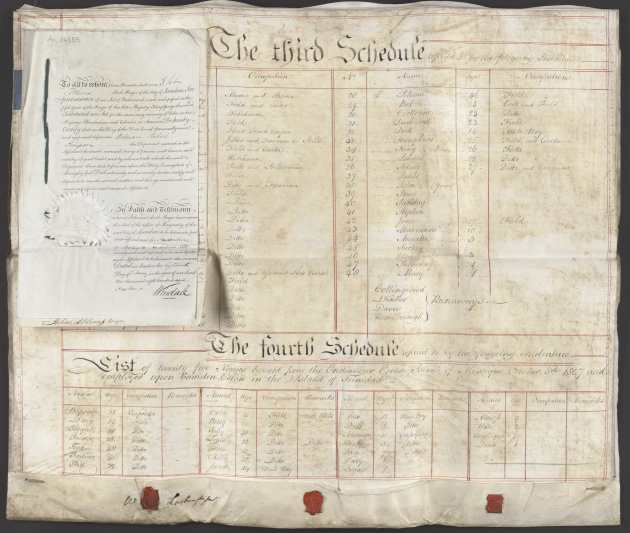Ralph McLean, Manuscripts Curator for the Long 18th Century, writes: The document is an indenture of release between William Lushington (1747-1823) and the Scotsmen John Stewart (1754/5-1826) and Alexander Fraser of Inchcoulter (1759-1837), which ultimately transferred ownership of the Camden Estate on Trinidad, and the enslaved workers, from Lushington to Stewart and Fraser.
Following the legal description of the plantation and ownership rights of both the physical plantation and the enslaved workers, there are four schedules containing information on the enslaved workers. The first schedule provides details on name, age, employment, split into men and women and boys and girls. The second (and largest) schedule is a ‘List of Families of slaves on the Plantation Camden’ containing information on first names, surnames, colour, employment, age, stature (height), Country (African Mandingo, African Congo, Creole of Trinidad, etc), Marks (distinguishing features), Relations (family connections on the estate). The third schedule is less than one page of the document and provides information on names, ages and occupations only – in addition to four ‘runaways’. The fourth schedule is less than half a page and refers to 25 enslaved people brought from the Endeavour estate on Mustique.
This indenture provides a level of detail on the enslaved people not always evident in such documents. This is important in helping to read against the grain: for example, the list of ‘runaways’ demonstrates resistance to enslavement. The detailed listing of skilled occupations, such as carpenters, masons and blacksmiths, illustrates the technical proficiency of the enslaved workers. As such, it is an important source in recovering silenced voices. The Scottish connection is further apparent given the number of Scottish surnames – Robertson, Murray, Mackenzie, Campbell, etc – imposed on the family groups of enslaved workers
Although they are not mentioned in the document, a further two Scots, James Evan Baillie (1781-1863) and Hugh Duncan Baillie (1777-1866) received financial compensation in 1834 following the emancipation of enslaved workers on the Camden plantation. They used the sums received to buy up land in Scotland (predominantly in the Highlands) between 1835 and 1838. Therefore the document is an important source that provides evidence of the extent to which Scottish infrastructure and commercial development benefitted from the proceeds of enslavement.
The National Library of Scotland holds significant collections relating to the Scottish involvement in slavery and the slave trade. These collections are contained in many of the family papers held at the Library, in addition to individual manuscripts that have been acquired over the years. As a result, the Library possesses one of the largest collections in the world recording the complicity of Scots in the Atlantic slave trade. This document complements those existing collections, and, given the level of detail which it contains, greatly enhances them. The Library is very grateful to the Friends of the National Libraries for their assistance in the purchase of this manuscript.
